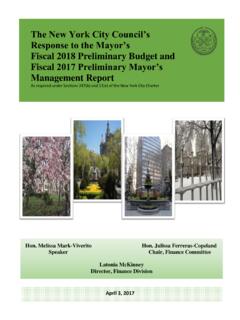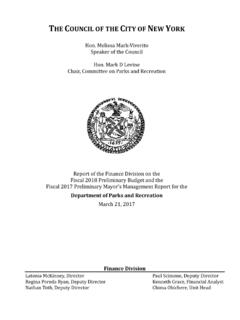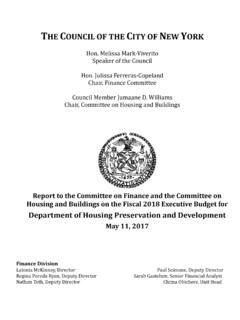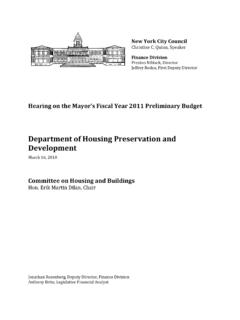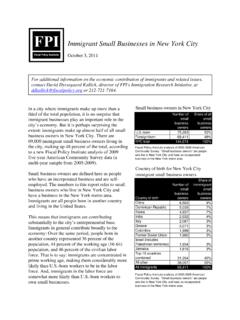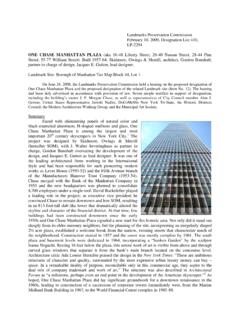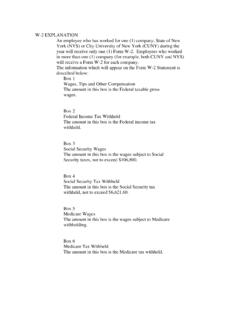Transcription of THE COUNCIL OF THE CITY OF NEW YORK
1 Finance Division Latonia McKinney, Director Paul Scimone, Deputy Director Regina Poreda Ryan, Deputy Director Jin Lee, Financial Analyst Nathan Toth, Deputy Director Crilhien Francisco, Unit Head Report of the Finance Division on the Fiscal 2018 Preliminary Budget and the Fiscal 2017 Preliminary Mayor s Management Report for the Mayor s Office of Immigrant Affairs Human Resources Administration Department of Youth and Community Development city University of New york March 22, 2017 THE COUNCIL OF THE city OF NEW york Hon. Melissa Mark-Viverito Speaker of the COUNCIL Hon.
2 Carlos Menchaca Chair, Committee on Immigration Finance Division Briefing Paper Immigrant Services Page i Table of Contents Report Overview .. 1 Immigrant New york .. 1 New york city Immigrant Population .. 1 English Proficiency .. 3 Economic Impact of Immigrants & Citizenship .. 4 Financial Summary .. 6 Expense Budget .. 6 COUNCIL Initiatives .. 8 Agency Budget .. 10 Mayor s Office of Immigrant Affairs .. 10 Human Resources Administration .. 11 Department of Citywide Administrative Services .. 15 city University of New york .. 17 Department of Youth and Community Development .. 18 Department of Education .. 21 State Executive Budget Highlights .. 24 Federal Highlights.
3 25 Executive Orders .. 25 President s Executive Budget for Fiscal 2018 .. 25 Sanctuary city .. 26 Federal Budget Uncertainty .. 27 Finance Division Briefing Paper Immigrant Services Page 1 Report Overview This report provides a review of the city s Fiscal 2018 Preliminary Budget for services for immigrant and foreign-born New Yorkers. This report reviews funding in the Mayor s Office of Immigrant Affairs (MOIA), which coordinates with city agencies, as well as funding for programs and services structurally found within other city agencies. The first section of this report presents highlights of immigration spending in the Fiscal 2018 Preliminary Budget expense budget, followed by an analysis of major initiatives by agency, initiatives funded by the COUNCIL , and the impact of State budget and federal actions.
4 The report then presents the city s spending on services that impact foreign-born New Yorkers by agency, provides analysis of significant program areas, discusses initiatives included in the Preliminary Financial Plan, and reviews relevant sections of the Preliminary Mayor s Management Report for Fiscal 2017. Immigrant New york New york city Immigrant Population The Census Bureau has estimated New york city s population at million as of July 2015. Of the total population, approximately million NYC residents are foreign-born immigrants, from more than 150 countries, who comprise nearly 40 percent of the city s The chart below shows that the foreign-born population in NYC has been steadily growing each decade.
5 Those from the Dominican Republic, China, Jamaica, Mexico, Guyana, and Ecuador comprise approximately 43 percent of the city s total foreign-born immigrant population. Furthermore, NYC is the fifth most popular destination for immigrants to settle in. 1 Office of the New york city Comptroller, Our Immigrant Population Helps Power NYC Economy, January 2017 24%28%36%37%02,000,0004,000,0006,000,000 8,000,00010,000,00012,000,00019801990200 02010 NYC Total Population vs. Foreign-Born PopulationForeign BornNYC PopulationSource: NHGISF inance Division Briefing Paper Immigrant Services Page 2 New york city is one of the most diverse cities in the country.
6 According to the NYC Comptroller s report, immigrants comprise 46 percent of the city s workforce. Immigrants are employed at the same rate as New Yorkers and they work as many or more hours per week, as well as more weeks per year, compared to New Yorkers. On average, percent of foreign-born immigrants work 50 to 52 weeks per year, compared to that of percent of born residents. Of the 501,000 self-employed New Yorkers, 53 percent are foreign born. Furthermore, a majority of business owners in the city (51 percent) are foreign-born. According to the Comptroller s report, immigrants earn $100 billion a year, which accounts for nearly one-third of all earned income in NYC.
7 Immigrant New Yorkers can be found in industries such as entertainment, medical, technology, and financial. Within the entertainment, medical, technology, and financial industries, 54 percent, 50 percent, 47 percent, and 44 percent of employees, respectively, are immigrants. 435,176 332,255 185,681 179,613 140,340 138,295 91,595 91,048 89,302 83,949 69,777 66,339 65,657 64,747 62,475 54,214 52,648 49,531 39,290 32,822 - 50,000 100,000 150,000 200,000 250,000 300,000 350,000 400,000 450,000 500,000 Dominican RepublicChinaJamaicaMexicoGuyanaEcuadorH aitiIndiaTrinidad & TobagoBangladeshColombiaUkrainePhilippin esKoreaRussiaPakistanPolandItalyHong KongPeruTop 20 Countries of Origin of New york city ImmigrantsSource: 2015 American Community Survey237,000 265,000 81,000 83,000 US BornForeign BornSelf-Employed New YorkersSelf EmployedSelf Employed in Own BusinessSource.
8 NYC Comptroller's OfficeFinance Division Briefing Paper Immigrant Services Page 3 English Proficiency While just six percent of native-born residents ages five and over were not proficient in English, close to one-half of the foreign-born were so classified. Among the foreign-born, approximately 8-in-10 Mexicans and Salvadorans were limited English proficient. According to a study done by the Population Division of the New york city Department of city Planning in 2013, while not all immigrant neighborhoods in NYC had problems with English proficiency, it was an issue in neighborhoods that had substantial native-born populations. For example, in the south Bronx, home to many native-born Hispanics who are from Puerto Rico, a high percentage of residents were not English proficient.
9 The percentage of those not proficient in English among Hispanic immigrants was uniformly high 64 percent or more of each Hispanic subgroup had problems speaking English. Additionally, among immigrant Asians, Chinese and Koreans had a high percentage not English proficient, 75 and 63 percent, respectively. Of the total NYC population, 23 percent are not English proficient, and 49 percent of foreign-born residents are not English proficient as of 2011 data. The chart below compares the languages spoken at home in NYC to New york Metro and New york State. Spanish is the second most frequently spoken language in NYC, with percent of the population speaking the language, after English.
10 For NYC as a whole, approximately 49 percent speak languages other than English in their homes. Those who speak languages other than English at home comprise a higher percentage in NYC, compared to those in New york Metro and New york State areas. This suggests that the city needs to invest more in English and literacy classes for its residents. Many newly arrived immigrants lack English-language proficiency and have to accept lower-level jobs than they may have held in their home countries. As a result, newly arrived immigrants tend to have a lower socioeconomic profile than those who arrived earlier. Over time, however, many new immigrants acquire language skills and further education that leads to qualifying them for higher-level positions, leading to an increase in earnings and socioeconomic attainment.

